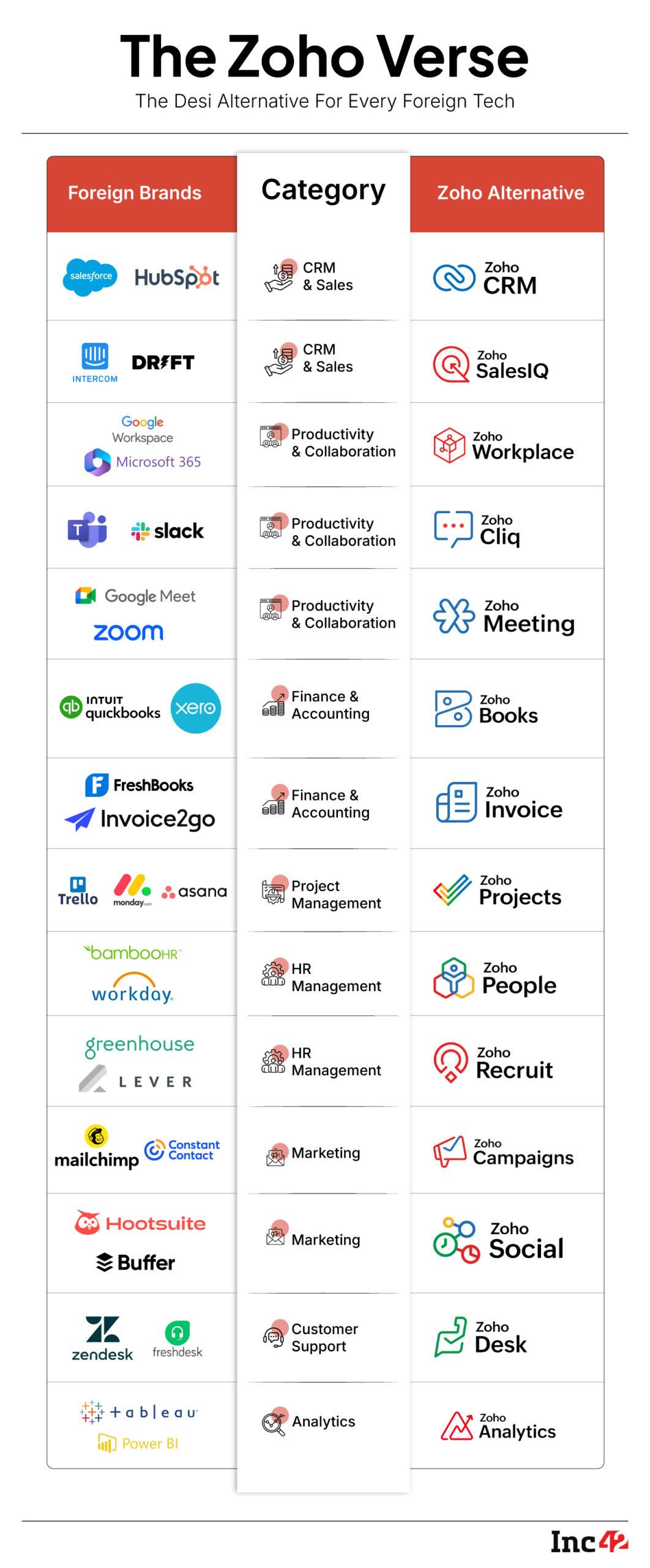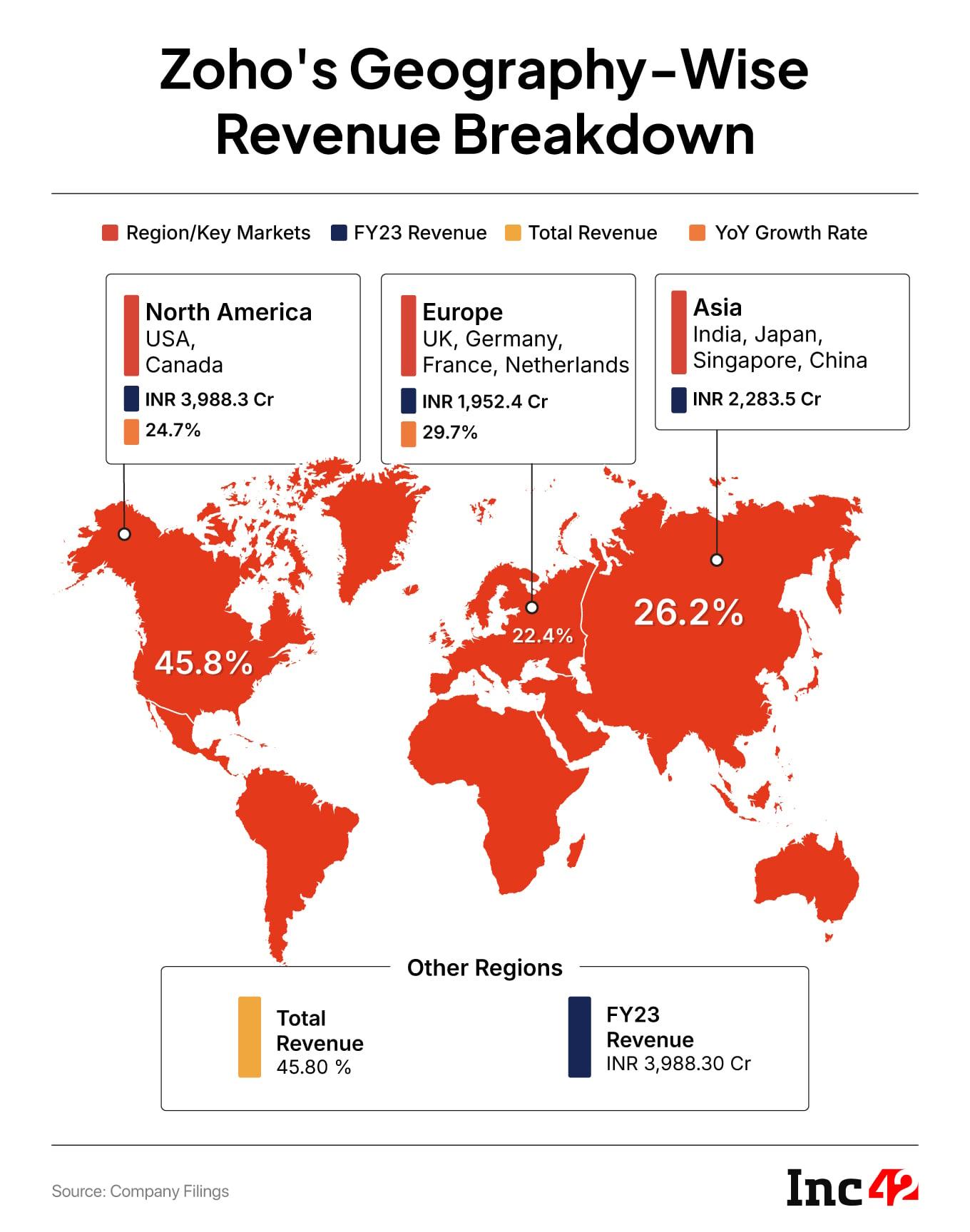Dear Reader,
Zoho is having its moment. From IT minister Ashwini Vaishnaw endorsing the SaaS giant’s software stack for official use to home minister Amit Shah announcing a switch to Zoho Mail in a Trumpesque post, Zoho has become the face of India’s latest “swadeshi” tech push.
The sudden spotlight marks quite a shift for the Chennai-based tech giant that’s spent 28 years thriving under the radar, building over 50 business apps, serving 100 Mn users worldwide, and generating $1 Bn+ in revenue — all without raising venture capital.
But Zoho is now under the spotlight after a few catalysts, including the India-US trade tensions, a call for sovereign tech and AI models, as well as the quest to create India’s own Microsoft, Google and Meta.
From developing a large language model (LLM) to reviving WhatsApp rival Arattai, the SaaS unicorn appears to be decked up for India’s sovereign tech moment.
And alongside this, Zoho’s push into robotics and its entry into fintech hint that the company has much bigger plans in the pipeline that are not just aligned to expanding its own universe, but also taking India’s tech global and building alternatives to foreign software.
So, beyond the hype, flashy vanity metrics for Arratai and government endorsement lie a more nuanced question – can Zoho challenge the might of deep-pocketed American tech giants?

Unlike India’s previous digital nationalist experiments, which often amounted to clones of Western platforms (think Koo vs X or Twitter), Zoho has spent two decades quietly building industrial-grade software infrastructure.
The company runs its entire operation on proprietary servers built and maintained by Indian engineers, hosts local data exclusively on Indian data centres, and pays taxes in the country on its worldwide income – a trifecta of sovereignty credentials no foreign competitor can match.
On top of it, Zoho crossed $1 Bn in revenue and achieved profitability years before nationalist sentiment became a tailwind, proving its products compete on merit. This solid foundation distinguishes Zoho from venture-backed startups that collapsed when hype faded.
It is this foundation that is now bearing fruit across three simultaneous fronts – indigenous AI development, viral consumer adoption, and enterprise tech push.
This is how Zoho is looking to cash in on India’s sovereign tech wave:
The Arattai MagicNothing captured Zoho’s unexpected ascent like Arattai, its messaging app that exploded from 3,000 daily signups to 3.5 Lakh in just three days after receiving endorsements from ministers.
Launched in 2021, but seeing a revival recently, Arattai, which means chitchat in Tamil, is preparing to rival WhatsApp and other messaging apps that have several times more users around the world. But, the kicker appears to be the homegrown app’s allure of end-to-end encryption, support for multiple local languages, zero data or ad monetisation, and its focus on integrating UPI and cross-platform messaging.
Even as Indians are embracing Arratai in recent weeks, there is the question of whether the app will attract global audiences to truly challenge bigger players.
Fintech FrenzyWhile Arattai dominated headlines for Zoho in the last month, the SaaS giant recently made an equally significant move into payments and fintech.
At the Global Fintech Fest 2025 last week, Zoho announced point of sale terminals, a QR soundbox, and integrated payment solutions to take on the likes of PhonePe, Paytm, Google Pay and others. While Zoho already provides accounting and finance software to small and medium businesses (SMBs), this is its first real foray into payments.
After securing its payment aggregator licence in early 2024, Zoho has spent the last 18 months embedding payments into every layer of its SaaS suite – from invoicing and accounting to payroll and marketplace settlements.
The payments tech is a major advantage as it allows Zoho to upsell its SaaS software to small merchants who would otherwise have to rely on multiple tools and software to manage their business and payments operations.
The Indic LLM AdvantageThe buzz around sovereign AI is undeniable and Zoho was one of the first proponents of building a language model, based on Indian language and India-specific data.
While global AI giants race to dominate enterprise software, Zoho has quietly built its own LLM Zia. Announced in July, the AI model comprises three subsets, trained specifically for business use cases — structured data extraction, summarisation, and code generation.
With AI at its core, Zoho has spruced up its productivity and SaaS software suite. While it already claims to match Microsoft “in both breadth and depth”, Zoho took it a notch higher when it launched Vani, a visual collaboration suite, earlier this month.
With fintech and Arratai as its new pillars, Zoho is also looking to create a network effect for its AI-powered SaaS products. If the UPI integration materialises for Arattai, it could become a big acquisition vehicle for the company’s SaaS and fintech products.
While other companies are building super apps, Zoho is creating an ecosystem of solutions that tie into each other.
Zoho’s India Focus SharpensPowering Zoho’s new experiments is its solid core SaaS business model. The unicorn crossed the INR 8,700 Cr ($1 Bn) revenue mark in FY23, with a healthy profit of INR 2,836 Cr. Since then, the company has not disclosed its financials, but the latest launches show that Zoho is focussing more deeply on India.
The high-margin North America and Europe markets collectively contributed 68% to its top line in FY23. In India, which is its fastest-growing market, Zoho’s products power millions of SMEs, startups, and large enterprises. But in revenue scale terms, India is far behind the top markets.
This perhaps explains why Zoho is now focussing on areas that matter to Indian SMEs such as payments, messaging and regional language SaaS. The company is aiming to position itself as a formidable alternative to entrenched global tech giants that have a near monopoly when it comes to business software.
The company is undeniably scaling impressive heights, setting new benchmarks in the way SaaS is done. Glowing endorsements from top Indian ministers and surging adoption of its apps has added fuel to the narrative.

But beneath the excitement lies a difficult truth – becoming the next Microsoft for India is not a linear path.
This is because Microsoft’s dominance isn’t built on just features or apps but rather by a global ecosystem, decades of trust-based enterprise relationships and a massive partner network worldwide. The big tech juggernaut shaped workplace culture for an entire generation, and replacing, or even replicating, it will take more than innovation.
Moreover, Microsoft aggressively invests billions of dollars annually in R&D, and has a vast pool of engineers and product teams spanning geographies. Zoho, despite its growth and higher scale relative to Indian SaaS companies, operates with a fraction of those resources and remains deeply India-focussed.
“Comparing Zoho to Microsoft or Google at this stage is premature,” said alternate asset management firm Artha Group’s director Anirudh A Damani.
According to him, Zoho’s real strength lies in operating in the blind spots (like overcharging) otherwise left unattended by the global players. “If Zoho stays true to its cause of building reliable, affordable, and transparent software that addresses the needs of the Global South, it has the potential to serve 60–70% of the world’s population.”
The bootstrapped approach is a differentiator, but it is a double-edged sword – it fosters independence and autonomy, but imposes scale limitations compared to the Silicon Valley behemoths.
Microsoft’s network effects and partner ecosystem also make it hard for enterprises to switch, posing a challenge that Zoho may take time to overcome. Cultivating global trust beyond India’s borders also remains a steep uphill battle for the SaaS major.
User experience is another hurdle that Zoho needs to improve and focus on. Unlike Microsoft’s polished and mature platforms, small businesses are open to accepting trade-offs around features and support in exchange for cost savings.
The company’s marketing campaigns have been geared towards small businesses, but to achieve its goal of becoming India’s homegrown tech giant, Zoho needs to bring in messaging for consumers, and position itself as a tech platform for all kinds of users.
For now, while Zoho’s ambition to become the Microsoft or Google for India may reflect its desire to become the poster boy for India’s sovereign tech movement, the reality is that the SaaS unicorn still has miles to go.
The post Zoho’s New Avatar appeared first on Inc42 Media.
You may also like

Households urged to pour baking soda down the drain in October

CBI arrests SBI official for taking Rs 10,000 bribe from Mudra loan applicant's husband

Teen fighting for his life after being mauled by shark at fishing hotspot

"Justice Gavai is true heir of Babasaheb Ambedkar's ideals," says Maharashtra Dy CM Eknath Shinde

Chloe Zhao reveals the areas of improvement for Hollywood






